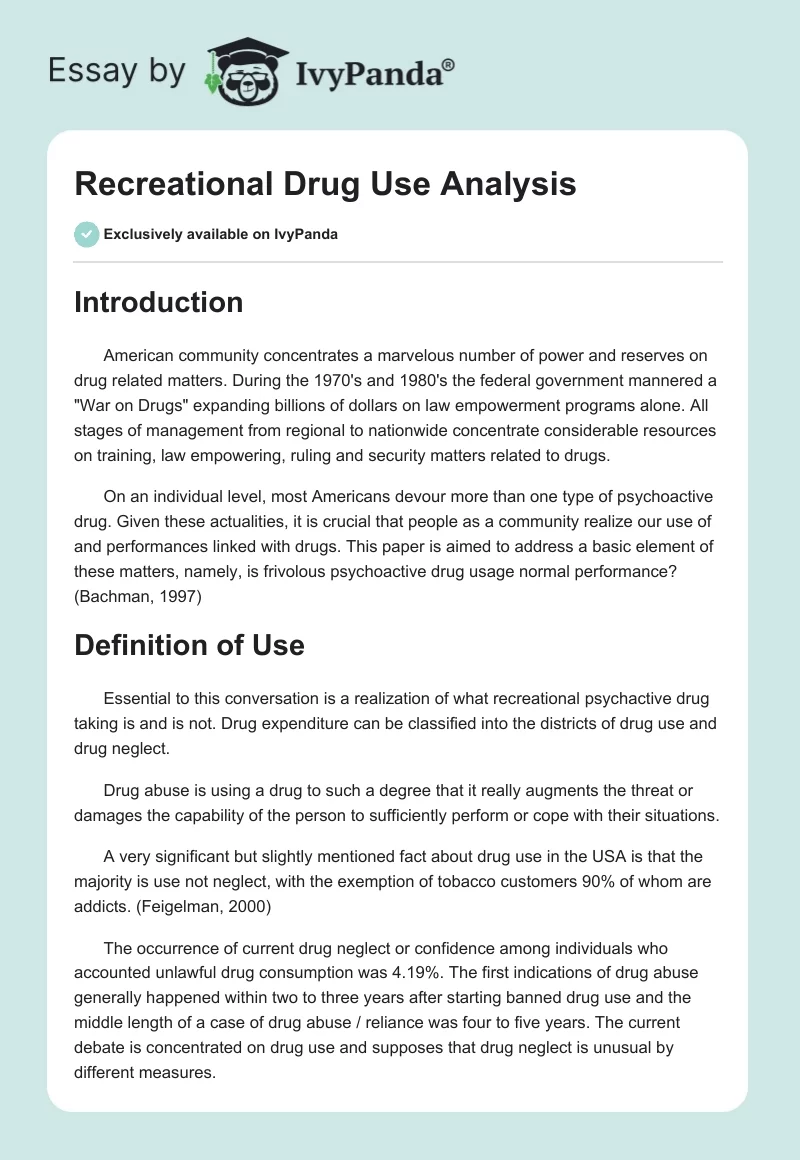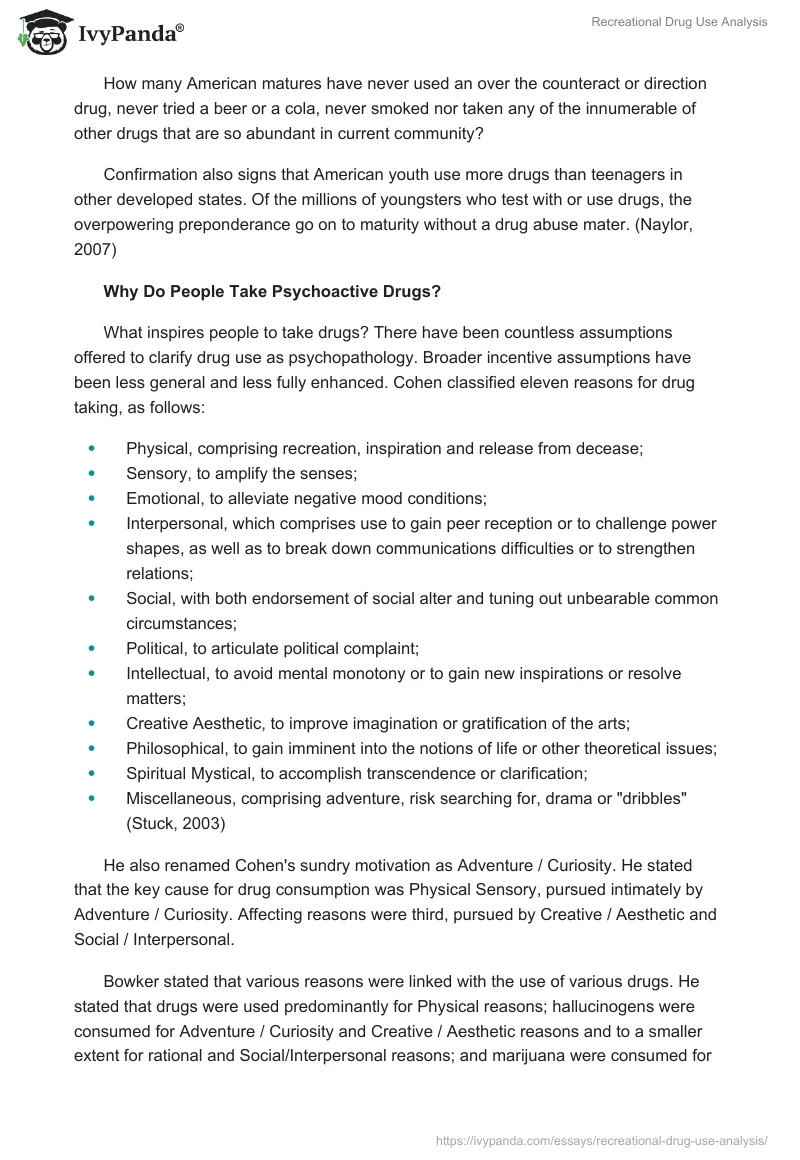Introduction
American community concentrates a marvelous number of power and reserves on drug related matters. During the 1970’s and 1980’s the federal government mannered a “War on Drugs” expanding billions of dollars on law empowerment programs alone. All stages of management from regional to nationwide concentrate considerable resources on training, law empowering, ruling and security matters related to drugs.
On an individual level, most Americans devour more than one type of psychoactive drug. Given these actualities, it is crucial that people as a community realize our use of and performances linked with drugs. This paper is aimed to address a basic element of these matters, namely, is frivolous psychoactive drug usage normal performance? (Bachman, 1997)
Definition of Use
Essential to this conversation is a realization of what recreational psychactive drug taking is and is not. Drug expenditure can be classified into the districts of drug use and drug neglect.
Drug abuse is using a drug to such a degree that it really augments the threat or damages the capability of the person to sufficiently perform or cope with their situations.
A very significant but slightly mentioned fact about drug use in the USA is that the majority is use not neglect, with the exemption of tobacco customers 90% of whom are addicts. (Feigelman, 2000)
The occurrence of current drug neglect or confidence among individuals who accounted unlawful drug consumption was 4.19%. The first indications of drug abuse generally happened within two to three years after starting banned drug use and the middle length of a case of drug abuse / reliance was four to five years. The current debate is concentrated on drug use and supposes that drug neglect is unusual by different measures.
How many American matures have never used an over the counteract or direction drug, never tried a beer or a cola, never smoked nor taken any of the innumerable of other drugs that are so abundant in current community?
Confirmation also signs that American youth use more drugs than teenagers in other developed states. Of the millions of youngsters who test with or use drugs, the overpowering preponderance go on to maturity without a drug abuse mater. (Naylor, 2007)
Why Do People Take Psychoactive Drugs?
What inspires people to take drugs? There have been countless assumptions offered to clarify drug use as psychopathology. Broader incentive assumptions have been less general and less fully enhanced. Cohen classified eleven reasons for drug taking, as follows:
- Physical, comprising recreation, inspiration and release from decease;
- Sensory, to amplify the senses;
- Emotional, to alleviate negative mood conditions;
- Interpersonal, which comprises use to gain peer reception or to challenge power shapes, as well as to break down communications difficulties or to strengthen relations;
- Social, with both endorsement of social alter and tuning out unbearable common circumstances;
- Political, to articulate political complaint;
- Intellectual, to avoid mental monotony or to gain new inspirations or resolve matters;
- Creative Aesthetic, to improve imagination or gratification of the arts;
- Philosophical, to gain imminent into the notions of life or other theoretical issues;
- Spiritual Mystical, to accomplish transcendence or clarification;
- Miscellaneous, comprising adventure, risk searching for, drama or “dribbles” (Stuck, 2003)
He also renamed Cohen’s sundry motivation as Adventure / Curiosity. He stated that the key cause for drug consumption was Physical Sensory, pursued intimately by Adventure / Curiosity. Affecting reasons were third, pursued by Creative / Aesthetic and Social / Interpersonal.
Bowker stated that various reasons were linked with the use of various drugs. He stated that drugs were used predominantly for Physical reasons; hallucinogens were consumed for Adventure / Curiosity and Creative / Aesthetic reasons and to a smaller extent for rational and Social/Interpersonal reasons; and marijuana were consumed for Adventure/Curiosity, Creative/Aesthetic, Social/Interpersonal, and Emotional matters. Cocaine was not involved in Bowker’s study. (Isralowitz, 2005)
Secondary school apprentices accounted using marijuana chiefly for Adventure / Curiosity and Creative / Aesthetic motives but Physical / Sensory, Emotional, and Social / Interpersonal reasons also had significant role. Hallucinogens were consumed overpoweringly for Creative / Aesthetic reasons, but a considerable preponderance of users were also stimulated by motives of Adventure / Curiosity. Drug using students accounted Adventure/Curiosity and poignant reasons. Bowker did not account the reasons of college scholars in any feature.
With the benefit of hindsight over the previous remarks, it is clear that the possible motives for using drugs are just about as varied as the total range of incentives for all human actions. Drugs are not consumed for unique motives which are precise only to drugs, nor are they taken mostly for pathological motives. They are taken by various individuals for various causes and by the same person for dissimilar motives during various periods.
The Concept of Normality and Drug Use
Statistical ordinariness is simply those performances in which a preponderance of populace connect. From the position of a normal curve replica normal performance would group around the mean while anomalous performance would be two or more standard divergences away from the denote. Since the majority of matures and teenagers use psychoactive drugs, “drug use” is commonly usual behavior. Drug neglect or a complete deficiency of drug taking activities is generally abnormal.
If one divides legal and illegal utilization a somewhat various picture appears. Illegal drug custom speeds are lower than the use of lawful drugs.
Medical deviation would be those performances, confusions or conditions which health experts categorize as displaying pathology or sickness. Instances would comprise pneumonia, cancer, bipolar confusion and schizophrenia. For drug taking performance the criteria for medical irregularity would be those for Substance Abuse Disorder or Substance Dependence Disorder as stated in the American Psychiatric Association’s Diagnostic and Statistical Manual of Mental Disorders. (Bachman, 1997)
In accordance with DSM IV, “the necessary attribute of Substance Abuse is a maladaptive prototype of material use cleared by recurring and important unpleasant results related to the repeated application of matters”. The principles for the confusion are that repeated use of the drug has outlined in at least one of the subsequent: failure to complete major role compulsions at work, school or home, use in circumstances in which it is bodily dangerous, repeated lawful matters, or unrelenting social or interpersonal matters.
“The significant feature of Substance Dependence is a bunch of cognitive, behavioral, and physiological indications revealing that the person goes on taking of the drug despite important associated problems”.
The analysis may be related when three or more of the subsequent criteria are coincided: patience; withdrawal; loss of control; unrelenting wish to or incapability to cut down; a great amount of time used for gaining, using and recuperating from results of the narcotic; giving up other performances in order to use the drug; went on using in spite of physical or mental matters reasoned by use. The mild, infrequent or leisure use of drugs, whether lawful or illicit clearly does not convene these criteria of scientific irregularity.
DSM IV, in fact, explicitly states that, “Substance Related Disorders are discriminated from non-pathological material use… by the attendance of lenience, withdrawal, obsessive use, or matter assisted matters”.
Moral familiarity is disturbed with the standard of right and wrong in connection to human exploit and temperament. Lots of persons view drug expenditure, chiefly of alcohol, tobacco and illegal drugs, as ethically incorrect.
Their dutiful dogma, for instance, may categorize this performance as a sin and next to the will of God. Conversely, Lots of others regard drug taking as performance that is not an honorable matter but rather an issue of personal choice or as an ethically satisfactory selection.
Legal ordinariness relays to the position of a performance in connection to the judicial structure. Nothing unlawful is abnormal while all legal performances are standard. The allocation or ownership of illegal drugs and the allocation of alcohol and tobacco to minors are thus lawfully abnormal.
Whereas, the ownership of or allocation to matures of alcohol and tobacco is lawful and usual under most situations. Exemptions to this would comprise drinking and driving and smoking tobacco in legally forbidden areas.
Probable benefits of this meaning comprise the clear, communally stated laws that public know about and can select to obey. Clifford states, though, that drug law enforcement differs across America contributing to augmented pessimistic outcomes of drug abuse in racial and racial minorities.
References
Bachman, Jerald G., et al. Smoking, Drinking, and Drug Use in Young Adulthood: The Impacts of New Freedoms and New Responsibilities. Mahwah, NJ: Lawrence Erlbaum Associates, 1997.
Feigelman, William. Treating Teenage Drug Abuse in a Day Care Setting. New York: Praeger Publishers, 2000.
Isralowitz, Richard E., and Darwin Telias. Drug Use, Policy, and Management. Westport, CT: Praeger Publishers, 2005.
Naylor, Adam H., Doug Gardner, and Len Zaichkowsky. “Drug Use Patterns among High School Athletes and Nonathletes.” Adolescence 36.144 (2007): 627.
Stuck, M. F. Adolescent Worlds: Drug Use and Athletic Activity. New York: Praeger Publishers, 2003.


